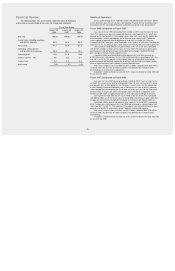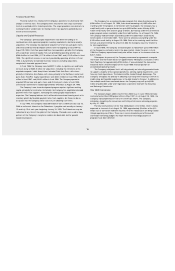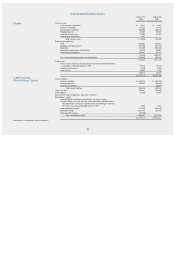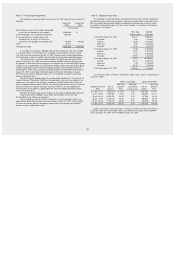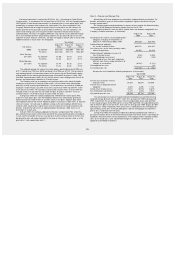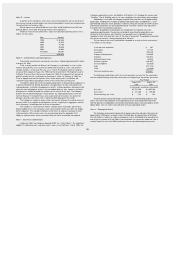AutoZone 1998 Annual Report Download - page 24
Download and view the complete annual report
Please find page 24 of the 1998 AutoZone annual report below. You can navigate through the pages in the report by either clicking on the pages listed below, or by using the keyword search tool below to find specific information within the annual report.
Notes To Consolidated Financial Statements
Note A – Significant Accounting Policies
Business: The Company is principally a specialty retailer of automotive parts and acces-
sories. At the end of fiscal 1998, the Company operated 2,657 auto parts stores in 38 states.
In addition, the Company sells heavy duty truck parts and accessories through its 43 TruckPro
stores in 14 states and automotive diagnostic and repair information software through its
ALLDATA subsidiary.
Fiscal Year: The Company’s fiscal year consists of 52 or 53 weeks ending on the last
Saturday in August.
Basis of Presentation: The consolidated financial statements include the accounts of
AutoZone, Inc. and its wholly owned subsidiaries (the Company). All significant intercompany
transactions and balances have been eliminated in consolidation.
Merchandise Inventories: Inventories are stated at the lower of cost or market using the
last-in, first-out (LIFO) method.
Property and Equipment: Property and equipment is stated at cost. Depreciation is com-
puted principally by the straight-line method over the estimated useful lives of the assets.
Leasehold interests and improvements are amortized over the terms of the leases.
Amortization: The cost in excess of net assets acquired is amortized by the straight-line
method over 40 years.
Preopening Expenses: Preopening expenses, which consist primarily of payroll and occu-
pancy costs, are expensed as incurred.
Advertising Costs: The Company expenses advertising costs as incurred. Advertising
expense, net of vendor rebates, was approximately $30,109,000 in fiscal 1998, $27,271,000 in
fiscal 1997 and $25,442,000 in fiscal 1996.
Warranty Costs: The Company provides the retail consumer with a warranty on certain
products. Estimated warranty obligations are provided at the time of sale of the product.
Financial Instruments: The Company has certain financial instruments which include
cash, accounts receivable and accounts payable. The carrying amounts of these financial
instruments approximate fair value because of their short maturities or variable interest rates.
The Company uses derivative financial instruments for purposes other than trading to minimize
the risk associated with financing activities. Settlements of interest rate swaps are accounted
for by recording the net interest received or paid as an adjustment to interest expense on a
current basis. Gains or losses resulting from market movements are not recognized. Contracts
that effectively meet risk reduction and correlation criteria are recorded using hedge account-
ing. Hedges of anticipated transactions are deferred and recognized when the hedged transac-
tion occurs.
Income Taxes: The Company accounts for income taxes under the liability method.
Deferred tax assets and liabilities are determined based on differences between financial
reporting and tax bases of assets and liabilities and are measured using the enacted tax rates
and laws that will be in effect when the differences are expected to reverse.
Cash Equivalents: Cash equivalents consist of investments with maturities of 90 days or
less at the date of purchase.
Use of Estimates: Management of the Company has made a number of estimates and
assumptions relating to the reporting of assets and liabilities and the disclosure of contingent
liabilities to prepare these financial statements in conformity with generally accepted account-
ing principles. Actual results could differ from those estimates.
Net Income Per Share: In fiscal 1998, the Company adopted Statement of Financial
Accounting Standards (SFAS) No. 128, “Earnings per Share.” SFAS No. 128 replaces pri-
mary and fully diluted earnings per share with basic and diluted earnings per share. Unlike
primary earnings per share, basic earnings per share excludes any dilutive effect of options.
Diluted earnings per share is based on the weighted average outstanding shares reduced by
the effect of stock options. All earnings per share amounts for all periods presented have been
restated to comform with SFAS No. 128 requirements.
Reclassifications: Certain prior year amounts have been reclassified to conform to cur-
rent year presentation.
Impairment of Long-Lived Assets: The Company complies with SFAS No. 121,
“Accounting for the Impairment of Long-Lived Assets and for Long-Lived Assets to Be
Disposed Of.” This statement requires that long-lived assets and certain identifiable intangi-
bles to be held and used by an entity be reviewed for impairment whenever events or changes
in circumstances indicate that the carrying amount of an asset may not be recoverable. Also,
in general, long-lived assets and certain identifiable intangibles to be disposed of should be
reported at the lower of carrying amount or fair value less cost to sell.
Comprehensive Income: In June 1997, the Financial Accounting Standards Board (FASB)
issued SFAS No. 130, “Reporting Comprehensive Income.” SFAS No. 130 is effective for
interim and annual periods beginning after December 15, 1997, although earlier adoption is per-
mitted. This statement establishes standards for reporting and display of comprehensive income
and its components. This statement requires only additional reporting, therefore its adoption in
fiscal 1999 will have no effect on the Company’s results of operations or financial position.
Disclosures about Segments of an Enterprise and Related Information: In June 1997,
the FASB issued SFAS No. 131, “Disclosures about Segments of an Enterprise and Related
Information.” Statement No. 131 revises existing guidelines for financial disclosure of a
Company’s operations and is effective for fiscal years beginning after December 15, 1997,
although earlier application is permitted. The adoption of this statement requires only additional
reporting and will not have any effect on the Company’s consolidated financial position or
results of operations. The Company will adopt this statement in fiscal 1999.
Pensions and Other Postretirement Benefits: In February 1998, the FASB issued
SFAS No. 132, “Employers’ Disclosures about Pensions and Other Postretirement
Benefits.” Although earlier adoption is permitted, this statement is effective for periods
beginning after December 15, 1997. SFAS No. 132 establishes new standards for the report-
ing of information about pension and other postretirement benefits. Adoption of SFAS No.
132 should not result in any significant changes in the Company’s presentation of pension and
other postretirement benefits. The Company will adopt SFAS No. 132 in fiscal 1999.
22





